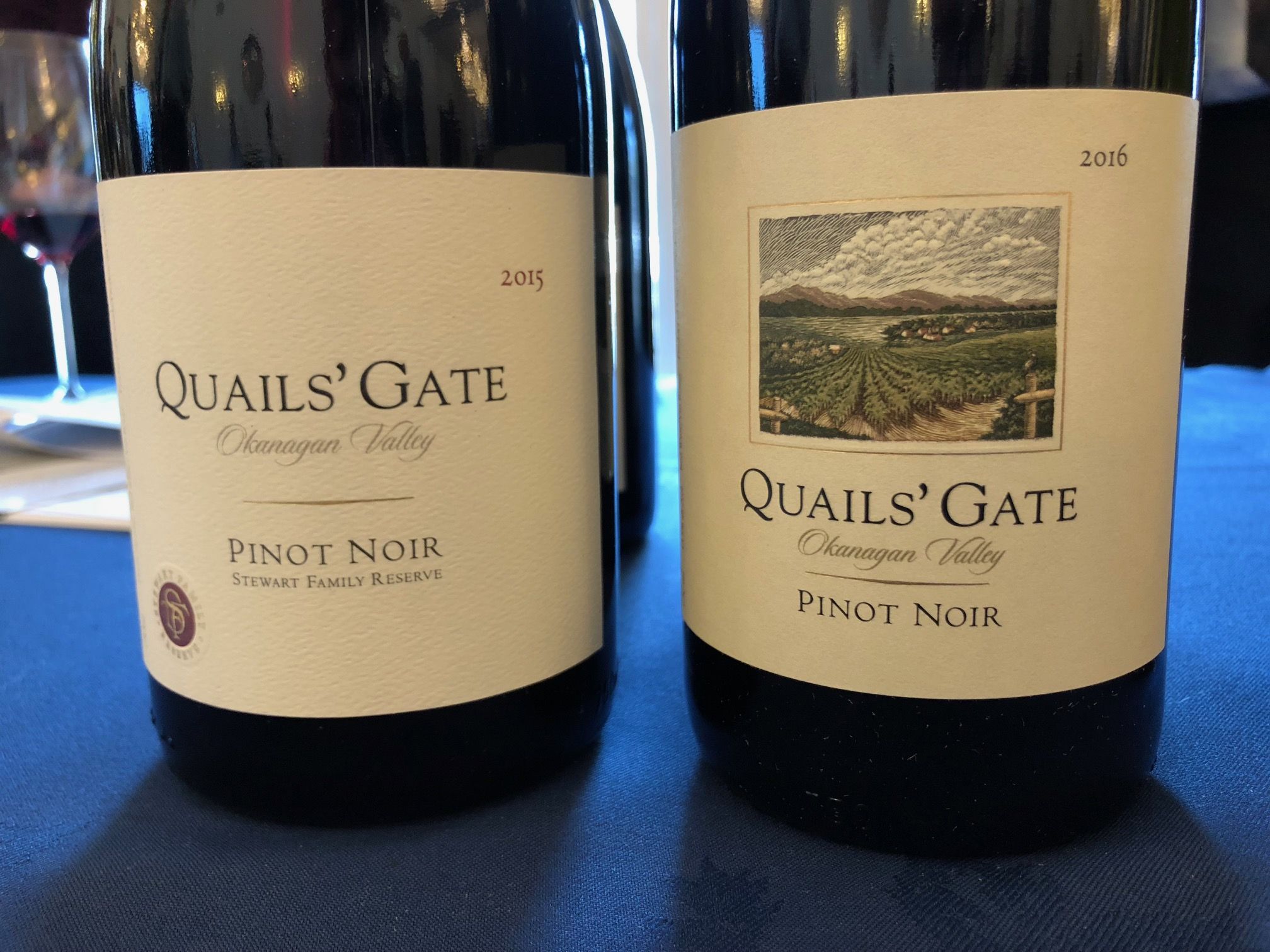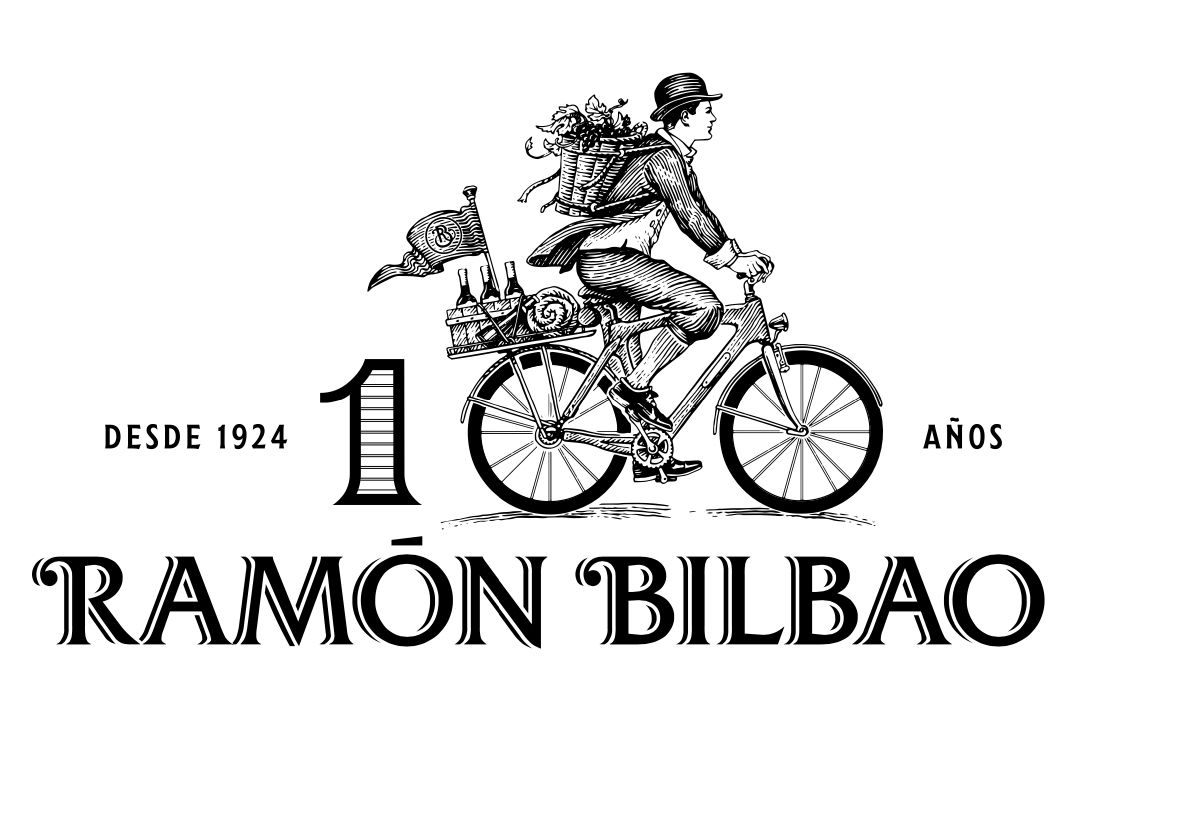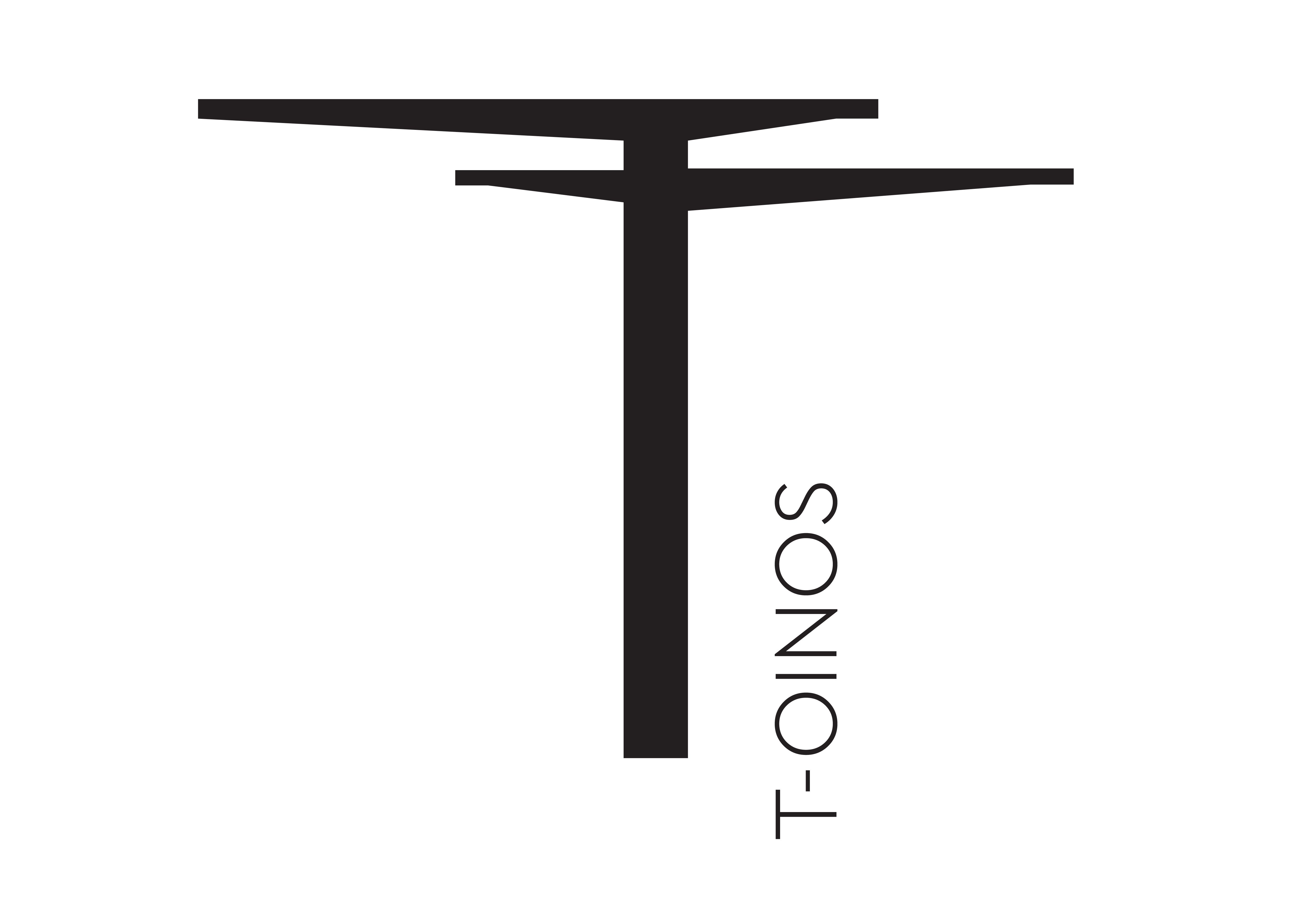The quality and consistency of the wines now being produced in Santorini are setting standards for the rest of the Greek wine industry to live up to, says Andrew Johnson.
This is not just an article on Assyrtiko, this is about my love affair, bordering on obsession, with this intoxicating niche grape variety that has magically found its perfect home on the volcanic island of Santorini.Try as others might, there is no other variety that has quite the same degree of salty electricity, pithy lemon core, sinuous acidy and undeniable minerality.But don’t just take my word for it. When Andrew Jefford summarises, “the most pronounced vin de terroir in the world. In no other wine can you smell and taste with such clarity the mineral soup and the bright sunlight which, gene-guided, structures the grape and its juice” (Andrew Jefford, Decanter Magazine, 2008), then wine drinkers should sit up and take note. For me, it also represents the current pinnacle of what is achieved in Greek wine.
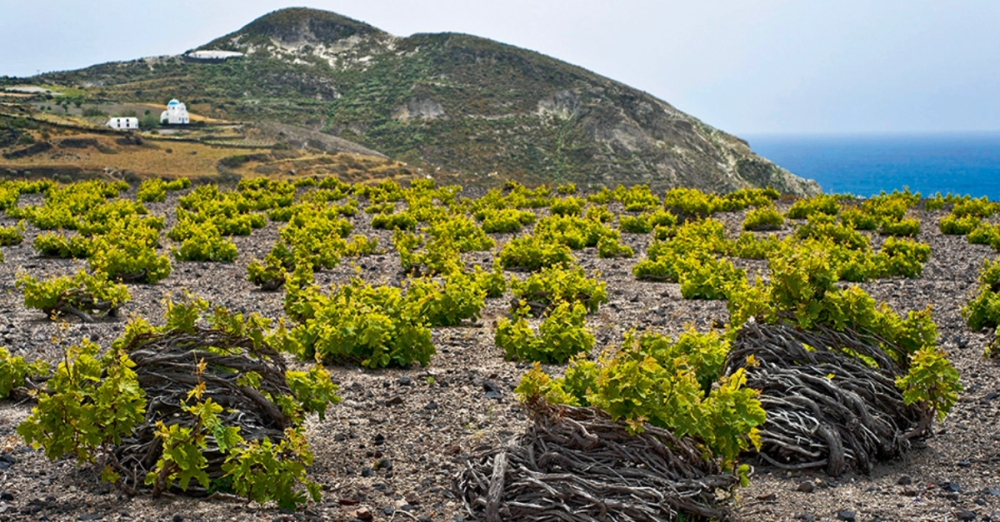
The basket trained vines are such a feature of the Santorini landscape. Picture Vasily Mulyukin
Of course, there are some good examples in neighbouring Crete: Lyrakis, Douloufakis and Diamantakis as well as some from the mainland: Papagiannakos, Vriniotis, Alpha, Mylonas and Pavlidis.But for me these are great wines but not great Assyrtikos.Assyrtiko from elsewhere almost always seems to have a more fruiter profile and without the same dynamic tension.
There have been some notable planting in South Australia (Jim Barry), California (Abbey of New Clairvaux), and South Africa (Jordon, Mullineux and Eben Sadie), and it will be interesting to see these results.Much in the same way my other love, Nebbiolo, only flourishes in Piedmont, the same can be said of Assyrtiko, whose homeland will always be Santorini.
Phylloxera free

Phylloxera free vines date back up to 200 years old on Santorini
The other unique attribute to this variety in Santorini is that it is phylloxera free and so the vines are on original rootstocks with many of the single vineyard expressions coming from vines of 150-200 years old and older. New plantings aside, the average age of vines seems to be over fifty and somewhere around eighty.Luckily it would appear the volcanic ash and soils serve as the perfect deterrent to the devastating potential of this destructive bug. How much of the distinctiveness is down to the root stock or the special cultivation (Kouloura), the soil, low yields of older vines, the lack of rain etc is of constant debate, but is this not the essence of terroir?
Fact time
Santorini is a medium sized island of around 28 square miles and is the southern most member of the Cyclades, which also lends its name to some of the island’s PGI wines. An astonishing one in 10 people on the island belong to grape growing families.Out of a population of 15,500, 1,200 growers already form the cooperative of Santo Wines (The Union of Santorini Cooperatives) alone; ergo the are some 350 further growers to provide grapes to the twenty or so wineries on the island.
Temperatures, even at the hight of summer, rarely exceed 30 degrees celsius but rain is scarce, with an average annual rainfall of around 350mm and much of this is classed as accumulative precipitation as it comes in the form of morning dew. The winds, known as the Meltemi, are notoriously vicious, reaching 100 km per hour in some parts of Greece. As a result of this Santorini has refined a training system called Kouloura or Ampelia, where the vines are trained in a twisted circle to form a protective basket to shield against the winds.
The dark side of the vines
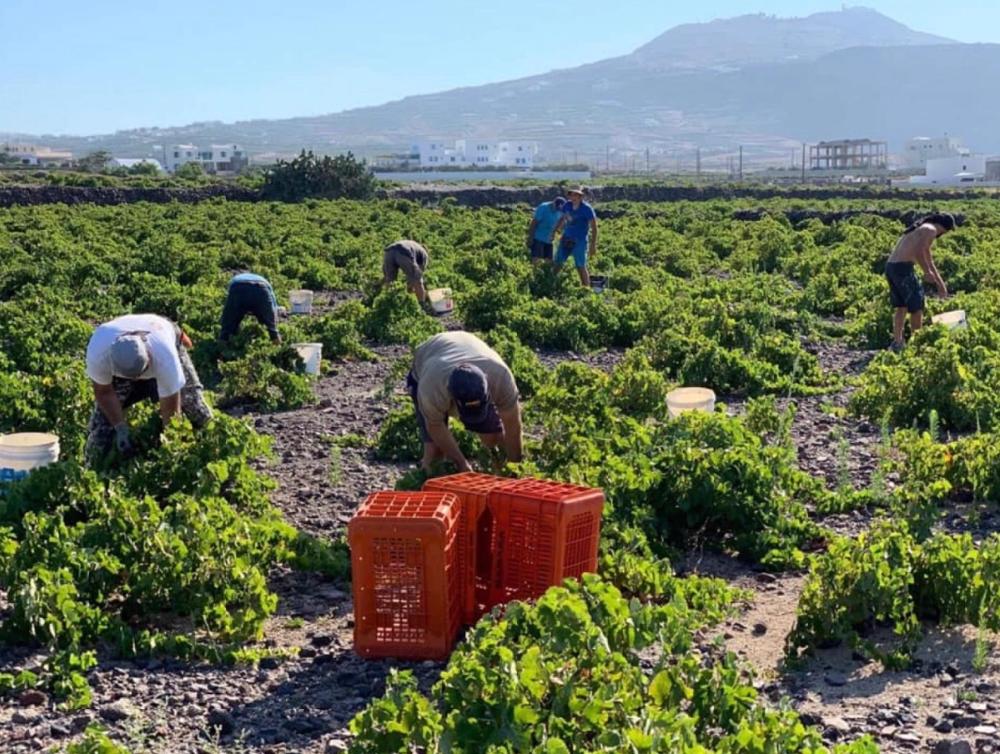
Grape pickers and growers in Santorini (picture Yiannis Karakasis MW)
Without question, the most emotive and complicated aspect to the wine industry in Santorini is the supply of grapes. The supply of grapes remains relatively static, but this is not as clear as it may appear. Some vineyards are being grubbed up while other land is being used for new plantings. Overall, while some wineries may have some of their own vineyards most grapes are provided by small growers.
Most deals, despite what wineries might tell you about long-term contracts, are done on hand shakes.This is an island with an island mentality. Who you know is as important, if not more, than how much you are willing to pay.
In 2010 a kilo of grapes would set you back €0.85.Eight years later that leaped to an average of €5 with same mentioning €6 or €7. Today, it appears prices have settled down at around €4.50 to €5 for good quality grapes. Of course, if you are trying to secure a parcel of ancient vines in one of the more premium vineyards, say Pyrgos or Megalochori then things might be more like €8 with certain parcels rumoured to reach around €10.
Some grapes are sold on the black market for various illicit reasons, but the primary one being that this allows the grower to pretend the vineyards have been fallow for 10 years and are then eligible to be grubbed up and the land sold, potentially, for redevelopment.
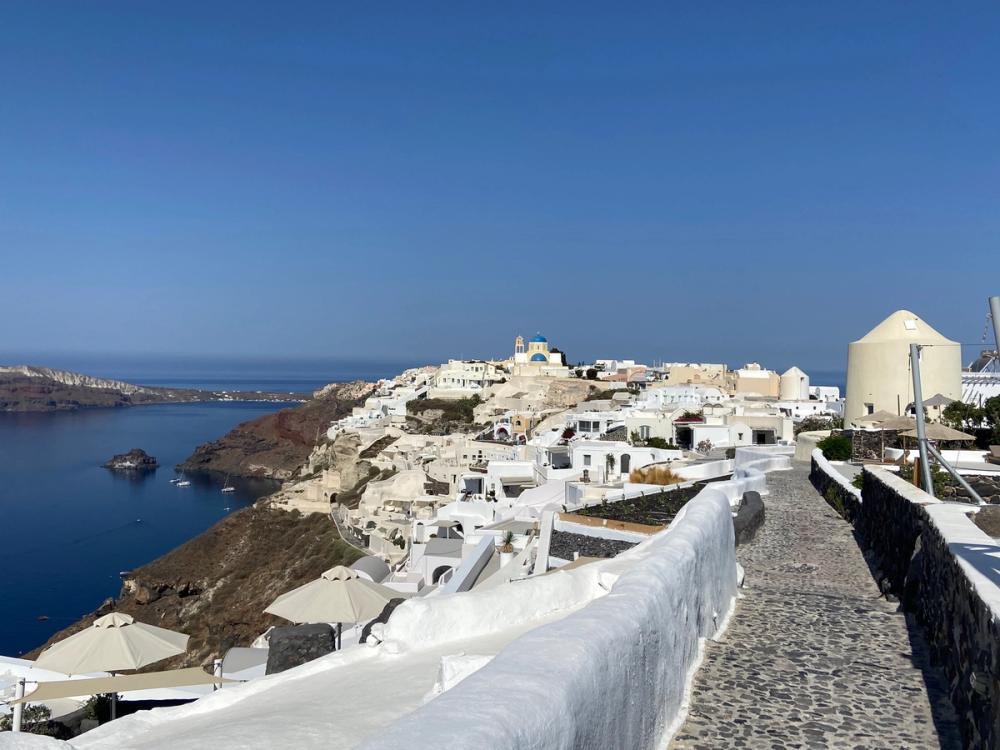
Santorini attracts hundreds of thousands of tourists every year…you can see why
The desire to build premium accommodation for the hordes of wealthy tourists continues. There are strict conservation rules, and even a push to have Santorini and its vines listed as a Unesco World Heritage Site, but this is Santorini, and this is Greece.Not all play by the rules, and this allegedly includes those outside and with administrative power. You can see the basic appeal of someone young inheriting land that is worth anywhere from €100k to €1m and being asked whether they want to cash in or sign up for the hard work of being a farmer.
All involved in this aspect of the island need to come together with a galvanized approach and safeguard this special resource. There are those pushing for this, but there are those (native Greeks) who say this type of camaraderie is hard to muster amongst Greeks.
Styles
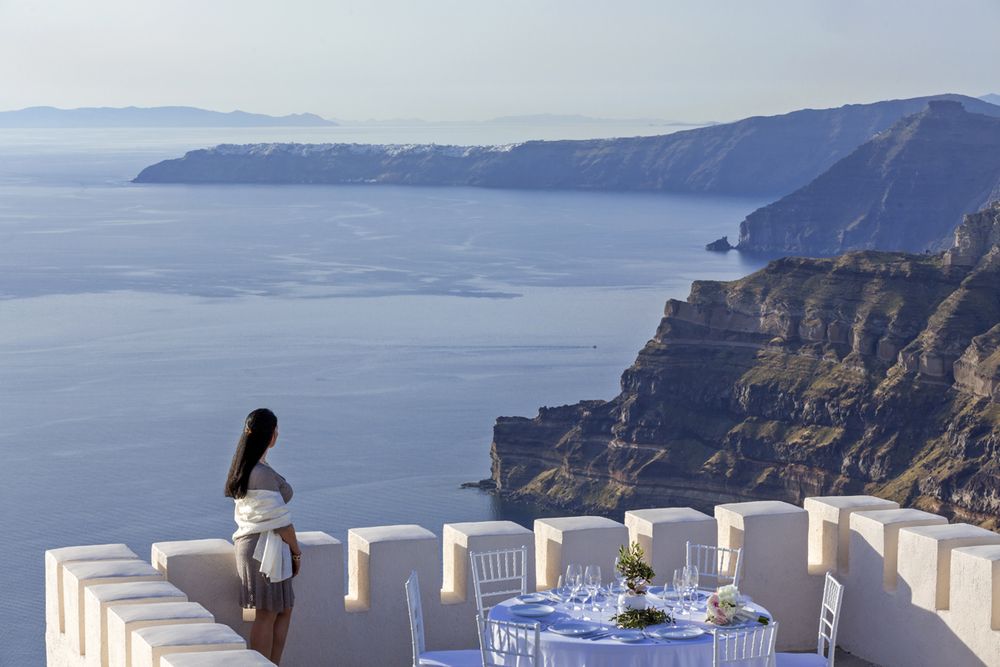
At the beginning of the pyramid are the wines classified as PGI Cyclades. These will often be similar to the PDO wines of Santorini, but the lesser classification allows for more diverse blending of either grape varieties or indeed grapes from other islands within the Cyclades.The three classic PDOs are as follows:
Santorini PDO or Santorini Assyrtiko PDO. This must be at least 85% Assyrtiko with the remainder being made of either Aidani or Athiri. This can be made in a variety of styles from pure stainless steel versions bursting with acidity and citrus drive, to more rounded versions with perhaps the addition of some oak to even skin contact versions.Lees ageing is common place for most wines.
Nykteri. This is essentially the same as Santorini PDO, but it must have a minimum alcoholic level of 13.5 percent and have spent three months in barrel either during fermentation or ageing.Traditionally this was made with late harvest grapes and was often made in an oxidative style. Today most wineries make the wines in a more reductive way but the oak regime can range from subtle to overtly spicy.Interestingly, some producers are abandoning this classification while some are returning to it.Nykteri hasn’t quite found it modern legs as yet.
Vinsanto. Renowned since the 12th century but acquired true fame in the 18th century when it was exported to the Russian market, today Vinsanto is made from a minimum of 51% Assyrtiko and the rest mainly from Aidani or Athiri, although some other indigenous varieties are allowed.The grapes are sun dried for around 10 to 14 days and then need to spend a minimum ageing period of two years. The wines then need to be released in multiples of four, so either four, eight, 12 or 16 year old.If they are not released with an ageing multiple of four years, then they need to have the date of harvest on the label.
Changing of the guard
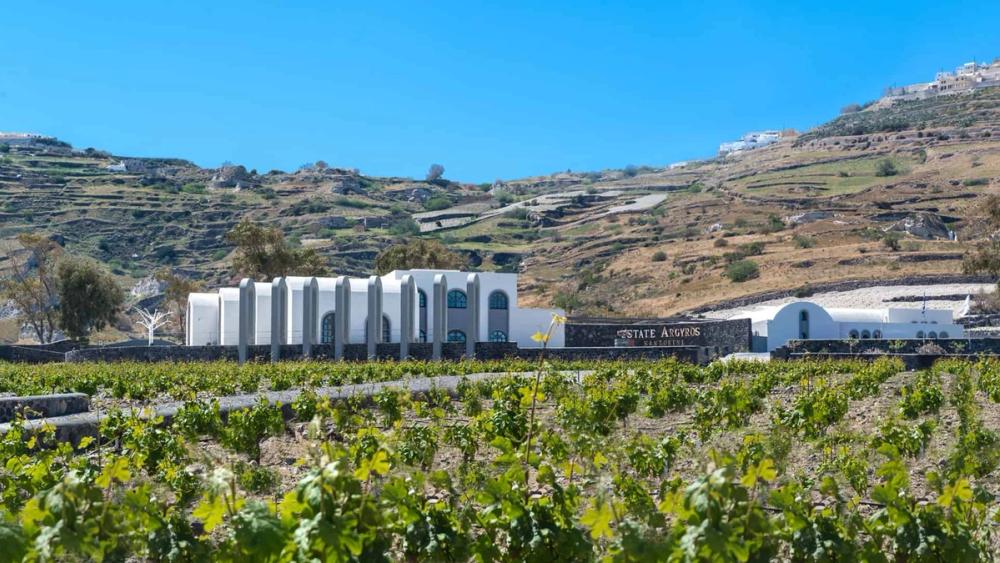
Argyros is one of Santorini’s biggest and most established wineries
There are approximately (things are changing fast at the moment) 20 wineries on the island. On the whole, you would have to say quality is very high. There are very few ‘bad wines’ but there is a definite sense that things are changing. There are a few of the historic wineries that are resting on their laurels or are going through a state of change, and an undeniable sense that many of the new wineries are forging ahead with energy and ambition trying to make the best wines they can.
Experimentation is very much at the heart of winemaking now. I lost count of how many amphora or concrete eggs I saw in wineries.These may not be new to many readers, but they are to Santorini. I saw a few more skin contact wines and one or two producers perhaps making a nod towards the old oxidative Nykteri style. Again, quality relies on getting the best grapes and so a winery’s mission is very much about viticulture and navigating the murky waters of the negociant system.
Wineries and Highlights
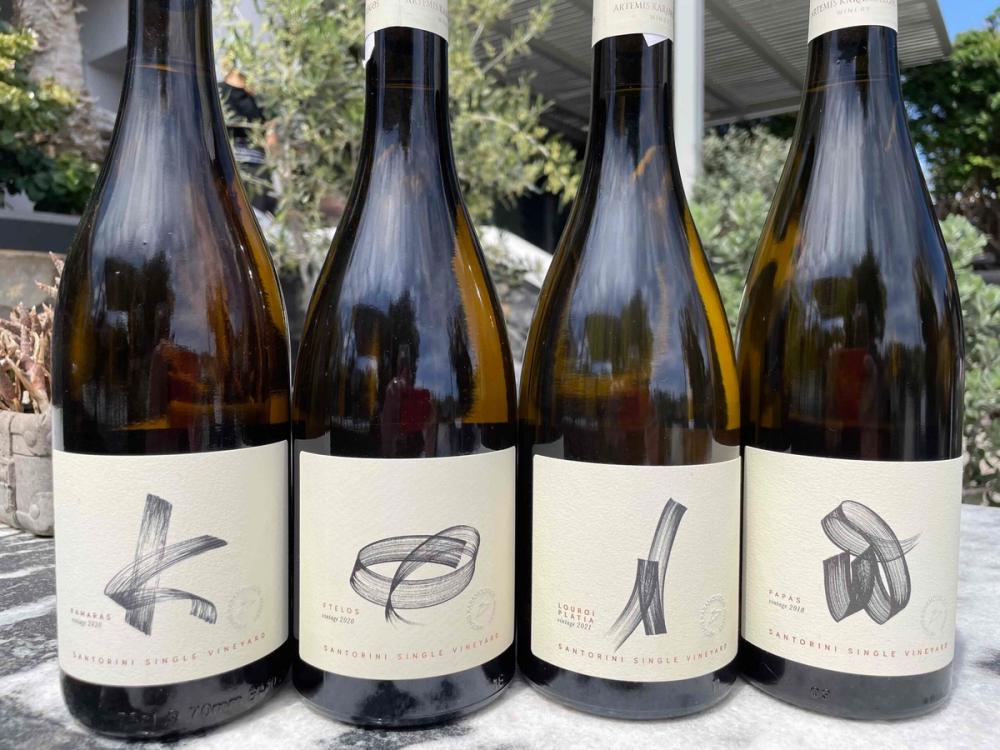
Woodwinters’ Andrew Johnson imports wines from Artemis Karamolegos
I must start out by declaring an interest here, as I import these wines into the UK. Since their current incarnation in 2004 Artemis Karamolegos has fast become one of the leading producers on the island, both in terms of quality and quantity – third largest. It produces 16 labels and has been pioneers in producing some of the islands best and most premium cuvees.These include Louroi Platia from 150 year old vines in Pyrgos and Karamas from 150 year old vines in Akrotiri.My two highlights of its premium cuvees were:
Ftelos 2020 – From a 150 year old Vineyard Thira, this wine showed piercing flinty and stony notes abounding from the glass, the promise of minerality is palpable. The palate is full of sea breeze and essence of lemon.This wine is full of sinuous tension with a firm grippy texture. The wine finishes with a melange of lemon pith, smoke, and stones.
Papas 2018 This wine comes from an exceptional plot of 150 year of vines in Megalochori. The austerity of this wine has just started to soften but is still full of tensile lemon acidity and notes of petrichor and volcanic soil. Hints of rockpool and lemon tea envelope the palate. This wine is incredibly textural and spicy on the finish.
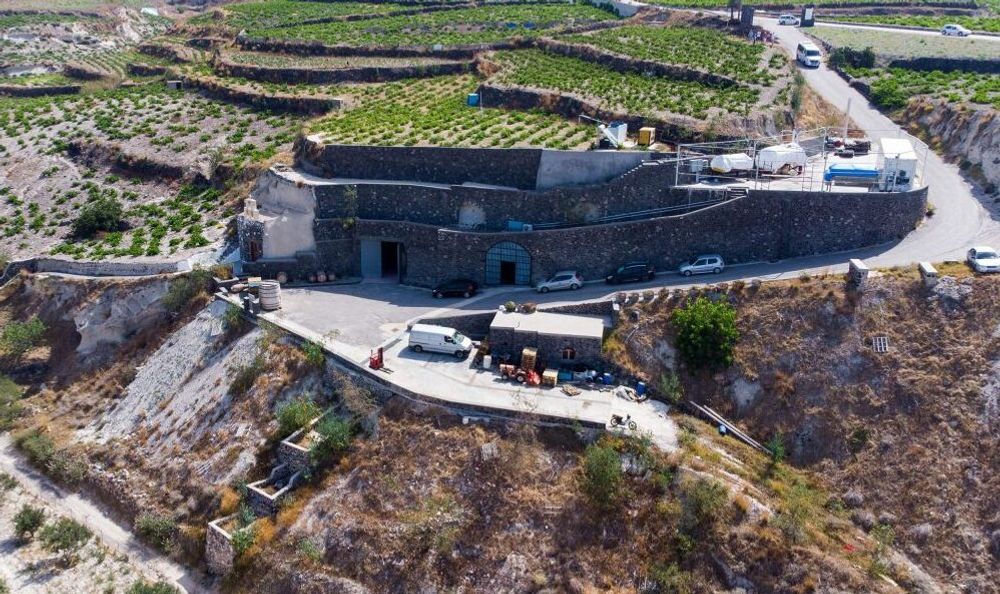
I am pleased to report that after what must have been a very turbulent six years after the passing of Haridimos Hatzidakis and the ensuing Covid period, the winery looks in great shape. Under the stewardship of Haridimos’s ex wife Konstantina Chryssou, and his daughters and son, the wines still have a unique and artisanal character. As well as paying homage to their father’s style and ethos, they are also starting to make new wines, expressing their own dynamic such as the (R)Ampelia 2022. Despite their elevated reputation this is a relatively small winery making around 70,000 bottles in total.
Cuvee 15, 2021. An old favourite of mine. Classic stoney and mineral Assyrtiko character on the nose, lovely firm texture on the palate with hints of lemon verbena and iced tea. This wine is held together with high tension acidity and a luscious salty finish.
Skitali Barrel 2018. So good and rare I bought one of only three hundred magnums produced.I am not always a fan of oaked Assyrtiko but there was so much briny and lemon pithiness to this wine that it adequately stood up to the oak French barrels which mainly added textured rather than any overtly vanilla characters.
One of the most historic wineries from the island, once owned by the maverick Paris Sigalas, in 2020 the remaining 60% of the shares were sold to the Martinos shipping family, the other 40% having already been sold to Yiannis Boutaris, founder of Kir-Yianni winery based in Naoussa. There have obviously been some substantial changes at the winery, and I got the sense the wines are still trying to find their feet.While they might lack the intensity of the past, especially the Kavaleiros and Nykteri, the wines offer a more approachable style of Assyrtiko, and perhaps this is now the aim under the new ownership.
7 Villages Vourvoulos 2021. Dried herbs and hints of stoniness. One can definitely feel the warmth of the village coming through with soft notes of camomile and jasmine.
Nykteri 2020.Spiced preserved lemons on the nose, with an almost warm sweet attack on the palate and hints of caramel.Some delicate and enjoyable hints of oxidation with an unexpected toffee and cream finish.
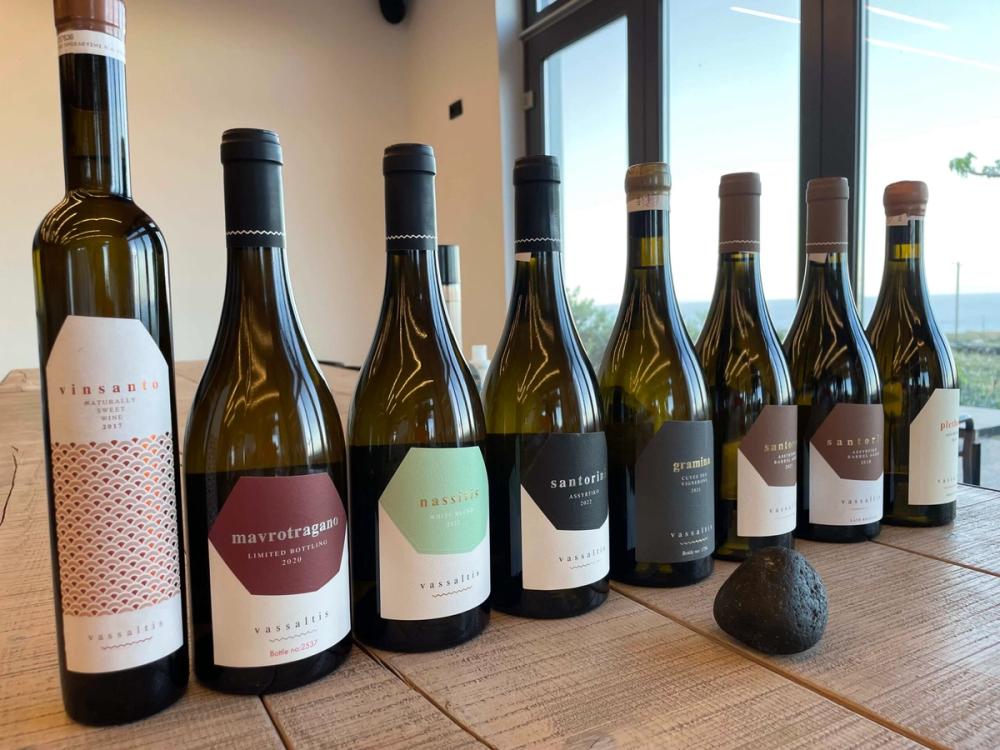
One of the newest wineries on the island with its maiden vintage in 2014. Based in Vourvoulos and run and owned by Yannis Valambous, who while not an islander himself, he and his family have had a long association with Santorini.Yannis is definitely a very modern man, and his wines are a reflection of that.There is a bold modernity to the wines with softer acidity and rounder, richer textures.There is a definite house style, and this is a welcome addition to the list of wineries on the island.
Plethora 2020. Made with a nod to the old Nykteri style. Incredibly complex, with notes of bruised orchard fruit and just the tiniest hint of caramel. Made in an oxidative style but still with bags of freshness. This is a wine that needs decanting and exploring over several hours.
Gramina 2021. Rich and smokey, hints of nuts and lemon curd. Very Burgundian in style but showing great brilliance helped by the night harvest to retain the natural freshness.

Undoubtedly one of the big players on the island with approximately 120 ha of their own vineyards.Like Artemis Karamolegos, they are one of the wineries to excel at entry level (this is a relative term) Assyrtiko and prestige cuvees. A very modern winery with a state of the art tasting facility to match.
Atlantis 2021. While this is their entry level wine, I thought it deserved praise as it is relatively good value at sub £20 and I remember seeing it at M&S for under £15.Grassy and stony with classic lemon and jasmine notes.A great introduction to Assyrtiko.
Cuvee Evdemon 2019. Many laud the praises of Cuvee Montsiniori but for me Evdemon was pure class and a notch above. From 160-year-old vines in Pyrgos, this wine displays a smokey, flint like minerality.The most beguilingly textural wine, coupled with delicate notes of green apple, citrus and white blossom.
One of the stalwarts of the island.They produce good authentic wines in a traditional style.They started production in the 1990s, produce around 110k bottles with 25% of their grapes coming from their own vineyards.
Natural Ferment 2022. Without a doubt, the star of the show for me is, and always has been the Natural Ferment.Six months on lees for this Megalochori fruit with asmall percentage in barrel.Bright lemony fruit, with a tangy almost sour and stony twist.Beautifully textured and very moreish.I wish they’d go natural ferments on all their whites.
Vinsanto 2016.Very layered. Burnt toffee and raisins meld with a beautifully rich and tannic structure.Being only a 2016 this still has lots of freshness and concentrated citrus notes on the finish.
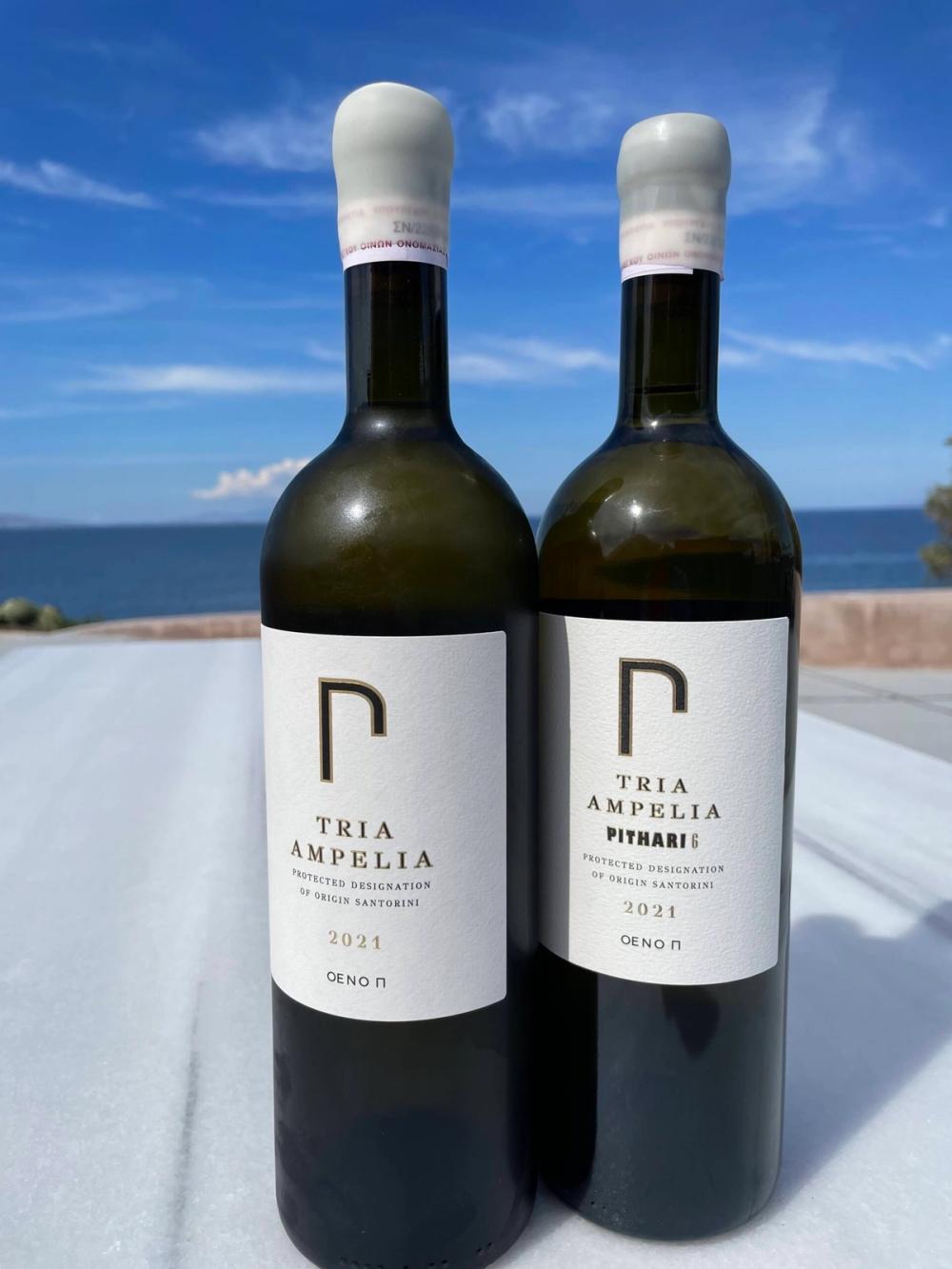
This is Paris Sigalas’s new project, just down the road from the old winery.There are those who thought that Paris should have become the father figure for Santorini wines, but Paris follows the beat of his own drum.Infuriating to some, a maverick to many and wildly unpredictable.A true character in the best sense of the word.The wines he now makes are nothing short of breath-taking.They are in a totally different style to Domaine Sigalas and in many ways are atypical versions of Santorini Assyrtiko.That being said, you should seek them out.
Tria Ampelia 2021. Very pure on the nose, like mountain dew. Very rich texture on the palate and quite broad.Not overtly mineral, but with very delicate hints of stones and white flowers.It has an almost Semillon like profile.Profound.
Tria Ampelia Pithari 6. This wine is a one off, and comes from one of the Amphora that had a stuck ferment.Instead of adding any nutrients to restart the fermentation, he decided to leave it as it was with its 6gr residual sugar.Despite the sugars, this is incredibly balanced with truly elegant nuances of stone fruit, camomile and jasmin.Almost defies analysis.
Founded in 1994 by Yiannis Paraskevopoulos, today production is overseen by his daughter Leto.One of the standard bearers, Gaia have been at the forefront of raising the profile of Santorini for many years.I feel a slight change in style.The wines feel more modern and the oak regime seems to be more present than before, giving a richer more rounded style on the whole.
Thalassitis 2021.An old favourite of mine, this is bursting with stony and salty notes on the nose.There is also a salty and tangy core to this wine.This feels the most authentic and shows the best typicity of all the wines.
This is one of the newer estates on the island, which is owned by the winery Avantis from Evia, just off the mainland with a modest production of around 45K bottles.Lefteris Anagnostou is also consultant winemaker of previous Artemis Karamolegos fame.
Krama 2022.This is essentially a winemaker’s blend made after fermentation and shows incredible citrus punch with delightful hints of peach and nectarine.Very pure on the mid palate with a subtle and elegant jasmine like finish.
Icon 2021.From Pyrgos fruit, and vinified in cement with one year on the lees this is full of acid tension.Its bone dry on the palate with a real sinuous texture.It ends with a very grown up and stony finish.
Santo Wines (The Union of Santorini Cooperatives)

Comprised of 1,200 growers, Santo wines is the largest producer of wine on the island, with an annual production of around 500k bottles.The winery complex is also a very important tourist destination attracting around 600K visitors annually.The wines aren’t always the most thrilling but they offer the average consumer a commercially friendly style of wine to begin their journey into the world of Santorini wine.
Santorini Selection Cuvee 2021.Made from one of their best tanks and with no adulterating oak, this wine best shows Assyrtiko’s character with a gentle sea breeze tang on the attack, followed by soft and sweet white blossom notes.It has a lovely purity and simplicity to it.
Roundup
Despite Steve Daniels’s valiant and ground breaking efforts back in the late 90s when he ran Oddbins, Greece has never quite managed to break out of the niche market.However, exciting things are happening and this seems like Greece’s moment.Spearheading this resurgence is undoubtedly Assyrtiko from Santorini.There is some special alchemy happening on the island and producers are now realising the potential of this magical grape.Its only taken Santorini about 3,400 years but finally Greece has a wine that can easily compete with any white wine in the world.
With Burgundy prices now becoming almost farcical, and prices elsewhere in the world painfully rising, more and more consumers will find their way to these mystical wines.Admittedly the wines aren’t cheap with a standard version starting around £20 and prestige cuvees toppling £100.
But the comparable value, especially in the £20 range is undeniable. Any self-respecting importer should now be looking to add Greece to their portfolio, be that from the Aegean islands, Peleponese, Central Greece or Macedonia.
Greece has finally woken up to its untapped potential and the new breed of either newly motivated or younger generation are moving away from the variable results of the past, so often based on international grape varieties, and have woken up to the fact that most buyers are looking for something unique and mainly based on indigenous varieties.
Santorini Assyrtiko is definitely the jewel in that crown.









